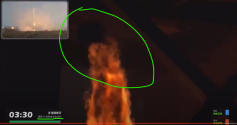There's a difference between having some reusable rocket research programs, which most major countries would have, vs having a sustained well funded program to commercialize reusable launch. Something like SpaceX.
And I don't need to believe other sources, I myself have read first hand quote and sources in the period 2015-16 from Chinese space bureaucrats and scientists dismissing commercial feasibility of SpaceX's approach.
You have seen all the information, news, or literature that I have undoubtedly read and understood, and I can be 100% certain that the information I have seen is definitely more than what you have seen. The disagreement between you and me lies in that one side, based on this information, believes that the Chinese space decision-makers at the time denied the feasibility of the VTVL (Vertical Takeoff, Vertical Landing) technical route of the Falcon 9. The other side does not feel that the Chinese space decision-makers have ever denied the development of a VTVL reusable rocket.
There is an idiom that describes the cause of this disagreement: taking things out of context.
I can be 100% sure that there is no problem with my observation. For example.
In the circle of Chinese space enthusiasts, there has always been a saying that in a certain CCTV television interview video in 2016, Academician Long Lehao, the former chief engineer of the CZ-3, publicly denied the Falcon 9 technical plan. Therefore, many people have always used this as a basis, saying that Chinese space is not enterprising. They cling to the unreliable parachute recovery and completely ignore the development trend of the industry. It indicates that Chinese space is extremely corrupt and decadent, with the old generation of technical oligarchs controlling Chinese space to decline day by day.
I have heard countless people repeat such views from 2013 to now.
Few people know that before the successful landing of the Falcon 9 in 2015 (December 2015), the people from the overall design department of Chinese space had proposed in the future use of CZ-9, to plan to achieve (with the goal of 2045), within a period of two years, the launch of 100-300 rockets, with a LEO (Low Earth Orbit) payload capacity of 100-200 tons, and the construction of a 20,000-ton class geostationary orbit space solar power station (kilometer-class spacecraft). Faced with such a high-density launch scenario, it is necessary to solve the reusability of heavy-lift launch vehicles. And the last person to sign this document is Academician Long Lehao.
Do you know this timeline? Before the end of 2015, Academician Long Lehao had agreed that heavy-lift launch vehicles of the CZ-9 class must develop VTVL reusable launch vehicles. However, the Chinese space enthusiast community, looking at a certain television interview in 2016, said that Academician Long Lehao denied the direction of VTVL rocket development and was a sinner of Chinese space.
I will also tell you that I have read the original text of Academician Long Lehao's interview. In my view, what Long Lehao said in 2016 was that the Falcon 9 had just successfully recovered, and whether the VTVL technology could successfully achieve large-scale application and truly reduce the cost of spaceflight still needs to be judged. The outside world should not be swayed by rumors and blindly demand that Chinese space follow suit.
If you are really engaged in technology, there is nothing wrong with what Academician Long Lehao said. The problem is how the outside world understands it? How do you understand it?
Chinese aerospace literature has long mentioned VTVL, VTHL (Vertical Takeoff, Horizontal Landing), HTHL (Horizontal Takeoff, Horizontal Landing), as well as parachute recovery. China is developing several technical routes. How many people really understand this?
Few people know that the deep throttling of the YF-100 was studied in 2008, but there was no follow-up. By 2014, the research was resumed, and the goal was a 10:1 thrust ratio.
How was the application requirement of YF-100's 10:1 thrust ratio proposed? If you reason it out in reverse, the answer is very simple. The minimum thrust of the YF-100's 10:1 model is 12 tons. The first stage of the CZ-7, with a single engine landing for the booster, can be achieved. The CZ-8R, with a first-stage rocket and two boosters, is only 30 tons. The YF-100's 10:1 model can achieve landing with two engines!
The key is that the YF-100's 10:1 model was initiated in 2014 or earlier. That is, by the latest in 2014, the overall design department of Chinese space had already issued tasks to the rocket power subsystem research and development units to study the key technologies of the power system for the relevant model rockets.
I knew that CZ-9 was to achieve reusable capabilities (VTVL) around 2035, which was 6-7 years ago. In addition to the document by Academician Long Lehao, Zhang Zhi, the chief engineer of the CZ-9 subsystem, mentioned it in the literature and in interviews with Xinhua News Agency in 2017-2018. Have you really seen these?
I only know that during that period, the various active space enthusiasts on the Chinese Internet, the big Vs, did not know these things. No one believed me when I said it. Few people read Chinese aerospace literature. They are all keyboard warriors playing the role of guiding the country through self-media.










